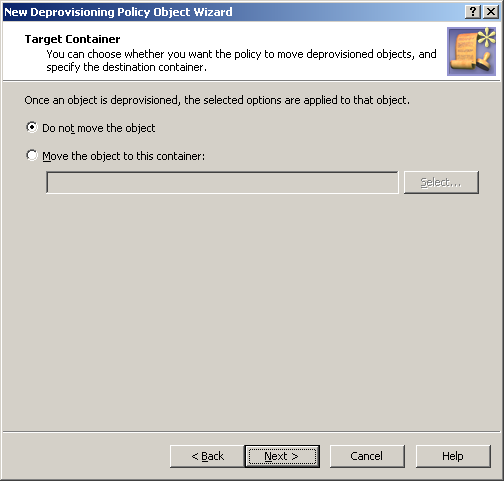Step 3: Applying the Policy Object
You can apply the Policy Object by using the Enforce Policy page in the New Provisioning Policy Object wizard, or you can complete the wizard and then use the Enforce Policy command on the domain, OU, or Managed Unit where you want to apply the policy. For more information on how to apply a Policy Object, see Applying Policy Objects and Managing policy scope earlier in this chapter.
Policies in this category are intended to automate the movement of deprovisioned group objects to specified organizational units. This removes such groups from the control of administrators that are responsible for management of the organizational units in which those groups originally reside. A policy in this category can also be configured not to move deprovisioned group objects.
When processing a request to deprovision a group, Active Roles uses this policy to determine whether to move the deprovisioned group object to a different organizational unit.
A policy configured to move group objects also specifies the destination organizational unit to which Active Roles moves deprovisioned group objects.
A policy can be configured not to move group objects. When applied at a certain level of the directory hierarchy, such a policy overrides any other policy of this category applied at a higher level of the directory hierarchy.
To configure a Group Object Relocation policy, select Group Object Relocation on the Policy to Configure page in the New Deprovisioning Policy Object wizard or in the Add Deprovisioning Policy wizard. Then, click Next to display the Target Container page.
Figure 99: Target container

On this page, you can choose whether you want the policy to move deprovisioned group objects, and select the destination container for the move operation.
First, select one of these options:
- Click Do not move the object for the policy to leave deprovisioned group objects in their original locations. With this option, each deprovisioned group object remains in the organizational unit it was in when it was deprovisioned.
- Click Move the object to this container for the policy to place deprovisioned group objects to a certain container. With this option, each deprovisioned group object is moved from its original location to a specified organizational unit.
The second option requires that you specify the organizational unit to which you want the policy to move deprovisioned group objects. Click the Select button, and then choose the organizational unit you want.
When you are done, click Next and follow the instructions in the wizard to create the Policy Object.

